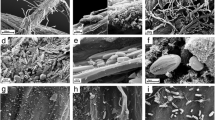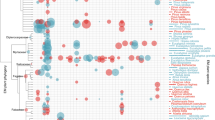Abstract
When roots are pulled from the ground, one cannot ignore the soil particles with their rhizosphere microbes still attached to the root surface and root hairs. The rhizosphere is home to a vast variety of microorganisms that associate with plants and either positively or negatively influences plant growth, while the rhizosheath is defined as the weight of soil strongly attached to the plant root surfaces. Root hairs, epidermal extensions that increase surface area, are a critical component of rhizosheaths. Within the root and in continuation with the aerial portion of the plant is the endosphere, providing both intra- and extracellular locations for microbial habitation. Endophytic microbes often enter plant roots through cracks in the epidermis or in areas where lateral roots emerge, or through stomata, openings for gas exchange, in the aerial parts of the plant. Microbial pathogens as well as symbionts and commensals enter into roots, stems, or leaves employing these “doorways” to enter plant tissues—sources of nutrients and carbon for microbes.
Access this chapter
Tax calculation will be finalised at checkout
Purchases are for personal use only
Similar content being viewed by others
References
Alori ET, Glick BR, Babalola OO (2017) Microbial phosphorus solubilization and its potential for use in sustainable agriculture. Front Microbiol 8:971
Backer R, Rokem JS, Ilangumaran G, Lamont J, Praslickova D, Ricci E, Subramanian S, Smith DL (2018) Plant growth-promoting rhizobacteria: context, mechanisms of action, and roadmap to commercialization of biostimulants for sustainable agriculture. Front Plant Sci 9:1473
Bashan Y, Holguin G (1998) Proposal for the division of plant growth-promoting bacteria into two classifications: biocontrol-PGPB (plant growth promoting Bacteria) and PGPB. Soil Biol Biochem 30:1225–1228
Beilsmith K, Thoen MPM, Brachi B, Gloss AD, Khan MH, Bergelson J (2019) Genome-wide association studies on the phyllosphere microbiome: embracing complexity in host-microbe interactions. Plant J 97:164–181. https://doi.org/10.1111/tpj.14170
Brown LK, Georg TS, Neugebauer K, White PJ (2017) The rhizosheath—a potential trait for future agricultural sustainability occurs in orders throughout the angiosperms. Plant Soil 418:115–128
Camacho M, Camacho M, Santamaría C, Temprano F, Rodriguez-Navarro DN, Daza A (2001) Co-inoculation with Bacillus sp. CECT 450 improves nodulation in Phaseolus vulgaris L. Can J Microbiol 47(11):1058–1062. https://doi.org/10.1139/w01-107
Cavicchioli R, Ripple WJ, Timmis KN, Azam F, Bakken LR, Baylis M, Behrenfeld MJ, Boetius A, Boyd PW, Classen AT, Crowther TW, Danovaro R, Foreman CM, Huisman J, Hutchins DA, Jansson JK, Karl DM, Koskella B, Mark Welch DB, Martiny JBH, Moran MA, Orphan VJ, Reay DS, Remais JV, Rich VI, Singh BK, Stein LY, Stewart FJ, Sullivan MB, van Oppen MJH, Weaver SC, Webb EA, Webster NS (2019) Scientists’ warning to humanity: microorganisms and climate change. Nature reviews. Microbiology 17(9):569–586. https://doi.org/10.1038/s41579-019-0222-5.
Compant S, Samad A, Faist H, Sessitch A (2019) A review on the plant microbiome: ecology, functions, and emerging trends in microbial application. J Adv Res 19:29–37
de Vries FT, Griffiths RI, Knight CG, Nicolitch O, Williams A (2020) Harnessing rhizosphere microbiomes for drought-resilient crop production. Science 368:270–274
Edwards DS (1986) Algaophyton major, a non-vascular land-plant from the Devonian Rhynie chert. Bot J Linn Soc 93:173–204
Elkoca E, Kantar F, Fe S (2007) Influence of nitrogen fixing and phosphorus solubilizing bacteria on the nodulation, plant growth, and yield of chickpea. J Plant Nutr 31(1):157–171
Estrada-de los Santos P, Palmer M, Chávez-Ramírez B, Beukes C, Steenkamp ET, Briscoe L, Khan N, Maluk M, Lafos M, Humm E, Arabit M, Crook M, Gross E, Simon MF, Bueno dos Reis Junior F, Whitman WB, Shapiro N, Poole PS, Hirsch AM, Venter SN, James EK (2018) Whole genome analyses suggest that Burkholderia sensu lato contains two further novel genera in the “rhizoxinica-symbiotica group” (Mycetohabitans gen. Nov., and Trinickia gen. Nov.): implications for the evolution of diazotrophy and nodulation in the Burkholderiaceae. Genes 9:389. https://doi.org/10.3390/genes9080389
Ferreira CMH, Soares HMVM, Soares EV (2019) Promising bacterial genera for agricultural practices: an insight on plant growth-promoting properties and microbial safety aspects. Sci Total Environ 682:779–799
Frank AB (1877) Über die biologischen Verkältnisse des Thallus einiger Krustflechten. Beiträge zur Biologie der Pflanzen 2:123–200
Gilbert JA, Neufeld JD (2014) Life in a world with microbes. PLoS Biol 12:e10002020
Glick BR (2012) Plant growth-promoting bacteria: mechanisms and applications. Publishing Corporation, Scientica. Article ID 963401 2012:15. https://doi.org/10.6064/2012/963401
Goswami D, Thakker JN, Dhandhukia PC (2016) Portraying mechanics of plant growth promoting rhizobacteria (PGPR): a review. Cogent Food Agric 2:1127500. https://doi.org/10.1080/23311932.2015.1127500
Honegger R, Axe L, Edwards E (2013a) Bacterial epibionts and endolichenic actinobacteria and fungi in the lower Devonian lichen Chlorochenomycites salopensis. Fungal Biol 117:512–518
Honegger R, Edwards E, Axe L (2013b) The earliest records of internally stratified and algal lichens from the lower Devonian of the welsh borderland. New Phytol 197:264–273
Janzen DH (1985) The natural history of mutualisms. In: Bouche DH (ed) The biology of mutualism. Oxford University Press, Oxford, pp 40–97
Kalayu G (2019) Phosphate solubilizing microorganisms: promising approach as biofertilizers. Int J Agron 2019. Article ID 4917256:7. https://doi.org/10.1155/2019/4917256
Korir H, Mungai NW, Thuita M, Hamba Y, Masso C (2017) Co-inoculation effect of rhizobia and plant growth promoting rhizobacteria on common bean growth in low phosphorus soil. Front Plant Sci 8:141. https://doi.org/10.3389/fpls.2017.00141
Kotyk ME, Basinger JF (2000) The early Devonian (Pragian) zosterophyll—Bathhurstia denticulata Hueber. Can J Bot 78:193–207
Lebeis SL, Paredes SH, Lundberg DS et al (2015) Plant microbiome. Salicylic acid modulates colonization of the root microbiome by specific bacterial taxa. Science 349:860–864. https://doi.org/10.1126/science.aaa8764.
Margulis L (1993) Origin of species: acquired genomes and individuality. Biosystems 31(2–3):121–125
Martínez-Hidalgo P, Hirsch AM (2017) The nodule microbiome: N2-fixing rhizobia do not live alone. Phytobiomes 1:70–82
Martínez-Hidalgo P, Maymon M, Pule-Meulenberg F, Hirsch AM (2018) Engineering root microbiomes for healthier crops and soils using beneficial, environmentally safe bacteria. Can J Microbiol 65:91–104. https://doi.org/10.1139/cjm-2018-0315
Mishra PK, Mishra S, Selvakumar G, Bisht JK, Kundu S, Gupta HS (2009) Coinoculation of Bacillus thuringeinsis-KR1 with Rhizobium leguminosarum enhances plant growth and nodulation of pea (Pisum sativum L.) and lentil (Lens culinaris L.). World J Microbiol Biotechnol 25:753–761
Nelson EB (2018) The seed microbiome: origins, interactions, and impacts. Plant Soil 422:7–34
Pasteur L (1885) Observation relative à la note précédente de M. Duclaux. Compte Rendus Ge. Acad Sci 100:68
Pirozynski KA, Malloch DW (1975) The origin of land plants: a matter of mycotrophism. Biosystems 6:153–164
Redecker D, Kodner E, Graham LE (2000) Glomalean fungi from the Ordovician. Science 289:1920–1921
Remy W et al (1994) Four hundred-million-year-old vesicular arbuscular mycorrhizae. Proc Natl Acad Sci U S A 91:11841–11843
Rodriguez R, Durán P (2020) Natural holobiome engineering by using native extreme microbiome to counteract the climate change effects. Front Bioeng Biotechnol 8:568. https://doi.org/10.3389/fbioe.2020.00568
Rohwer F, Seguritan V, Azam F, Knowlton N (2002) Diversity and distribution of coral associated bacteria. Mar Ecol Prog Ser 243:1–10
Rosenberg E, Zilber-Rosenberg I (2018) The hologenome concept of evolution after 10 years. Microbiome 6:78. https://doi.org/10.1186/s40168-018-0457-9
Rosenberg E, Koren O, Reshef L, Efrony R, Zilber-Rosenberg I (2007) The role of microorganisms in coral health, disease and evolution. Nat Rev Microbiol 5:355
Rubenstein CV, Gerrienne P, de la Puente GS, Astíni RA, Steemans P (2010) Early middle Ordovician evidence for land plants in Argentina (eastern Gondwana). New Phytol 188:365–369
Ruzzi M, Aroca R (2015) Plant growth-promoting rhizobactertia act as biostimulants in horticultures. Sci Hortic 196:124–134
Sattar A, Naveed M, Ali M, Zahir ZA, Nadeem SM, Yaseen M (2019) Perspectives of potassium solubilizing microbes in sustainable food production system: a review. Appl Soil Ecol 133:146–159
Schwartz AR, Ortiz I, Maymon M, Herbold CW, Fujishige NA, Vijanderan JA, Villella W, Hanamoto K, Diener A, Sanders ER, DeMason DA, Hirsch AM (2013) Bacillus simplex—a little known PGPB with anti-fungal activity—alters pea legume root architecture and nodule morphology when coinoculated with Rhizobium leguminosarum bv. viciae. Agronomy 3:595–620. https://doi.org/10.3390/agronomy3040595
Smercina DN, Evans SE, Friesen ML, Tiemann LK (2019) To fix or not to fix: controls on free-living nitrogen fixation in the rhizosphere. Appl Environ Microbiol 85:e02546–e02518
Stein WE, Berrry CM, Morris JL, Hernick LV, Mannonlini F, Ver Straeten C, Landing E, Marshall JEA, Wellman CH, Beerling DJ, Leake JR (2019) Mid-Devonian Archaeopteris roots signal revolutionary changes in earliest fossil forests. Curr Biol 30:421. https://doi.org/10.1016/j.cub.2019.11.067
Strother PK, Al-Hajri S, Traverse A (1996) New evidence for land plants from the lower middle Ordovician of Saudi Arabia. Geology 24:55–58
Suárez Díaz J (2019) The Hologenome concept of evolution: a philosophical and biological study. PhD thesis, University of Exeter, Exeter, The United Kingdom
Tomescu AMF, Honegger R, Rothwell GW (2008) Earliest fossil record of bacterial-cyanobacterial mat consortia: the early Silurian Passage Creek biota (440 ma, Virginia, USA). Geobiology 6:120–124
Uroz S, Calvaruso C, Turpault MP, Frey-Klett P (2009) Mineral weathering by bacteria: ecology, actors and mechanisms. Trends Microbiol 17:378–387
Watanabe Y, Martini JEJ, Ohmoto H (2000) Geochemical evidence for terrestrial ecosystems 2.6 billion years ago. Nature 408:574–578. https://doi.org/10.1038/35046052
Xue J, Deng Z, Huang P, Huang K, Benton MJ, Cui Y, Wang D, Liu J, Shen B, Basinger JF, Hao S (2016) Belowground rhizomes in paleosols: the hidden half of an early Devonian vascular plant. Proc Natl Acad Sci 113:9451–9456
Zeffa DM, Fantin LH, Koltun A, Oliveira ALM, Nunes MPBA, Canteri MG, Goncalves LSA (2020) Effects of plant growth-promoting rhizobacteria on co-inoculation with Bradyrhizobium in soybean crop: a meta-analysis of studies from 1987 to 2018. Peer J 8:e7905. https://doi.org/10.7717/peerj.7905
Zilber-Rosenberg I, Rosenberg E (2008) Role of microorganisms in the evolution of animals and plants: the hologenome theory of evolution. FEMS Microbiol Ecol 32:723–735
Acknowledgements
We thank the Fulbright Foundation for supporting S. Kouas’ stay in the Hirsch lab, and also acknowledge the long-term grant support from the Shanbrom Foundation to study arid soils and their microbes. Thanks to S.J. Kirchanski for his helpful comments on the manuscript, and we also extend our gratitude to J.W. Schopf, J.F. Basinger, W.E. Stein, T. Algeo, D. Murphy, and J. Shen-Miller for their helpful comments, suggestions of papers, and answers to various questions sent by email. Allan Chong (UCLA) did the artwork for Fig. 21.2. We also thank Christon J. Hurst for his support and helpful comments.
Finally, we appreciate P. G. Gensel and D. Edwards for writing the book “Plant Invade the Land. Evolutionary and Environmental Perspectives”, which was an important reference for this chapter.

Saber Kouas

Noor Khan

Ann M. Hirsch
Author information
Authors and Affiliations
Corresponding author
Editor information
Editors and Affiliations
Rights and permissions
Copyright information
© 2021 Springer Nature Switzerland AG
About this chapter
Cite this chapter
Kouas, S., Khan, N., Hirsch, A.M. (2021). The Hologenome Hypothesis and Its Application to Plant-Microbe Interactions on an Evolutionary Scale. In: Hurst, C.J. (eds) Microbes: The Foundation Stone of the Biosphere. Advances in Environmental Microbiology, vol 8. Springer, Cham. https://doi.org/10.1007/978-3-030-63512-1_21
Download citation
DOI: https://doi.org/10.1007/978-3-030-63512-1_21
Published:
Publisher Name: Springer, Cham
Print ISBN: 978-3-030-63511-4
Online ISBN: 978-3-030-63512-1
eBook Packages: Biomedical and Life SciencesBiomedical and Life Sciences (R0)




